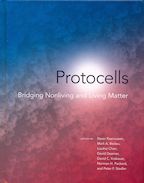Protocells offers a comprehensive resource on current attempts
to create simple forms of life from scratch in the laboratory.
These minimal versions of cells are entities with lifelike properties
created from nonliving materials; the book provides in-depth investigations
of processes at the interface between nonliving and living matter.
Chapters by experts in the field put this state-of-the-art research
in the context of theory, laboratory work, and computer simulations
on the components and properties of protocells.
The book also provides perspectives on research in related areas
and such broader societal issues as commercial applications and ethical considerations.
The book covers all major scientific approaches to creating minimal life, both in the laboratory and in simulation. It emphasizes the bottom-up view of physicists, chemists, and material scientists but also includes the molecular biologists top-down approach and the origin-of-ljfe perspective. Ihe capacity to engineer living technology could have a enormous socio-economic impact and could bring both good and ill. Protocells promises to be the essential reference for research on bottom-up assembly of life and living technology for years to come.
